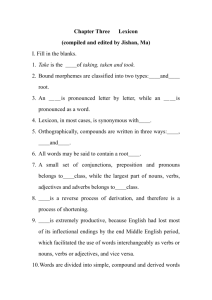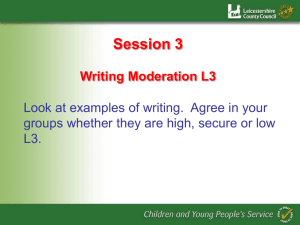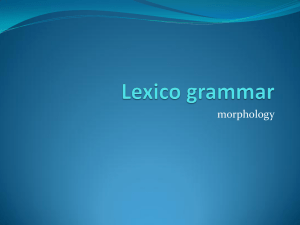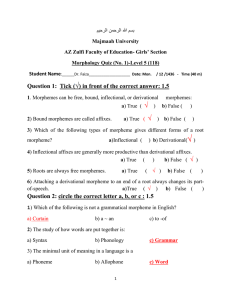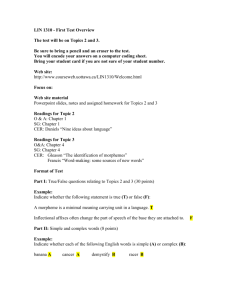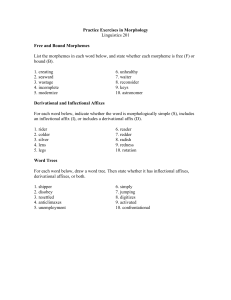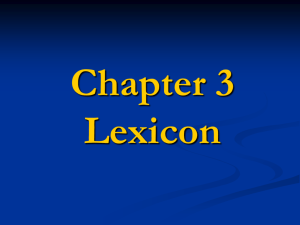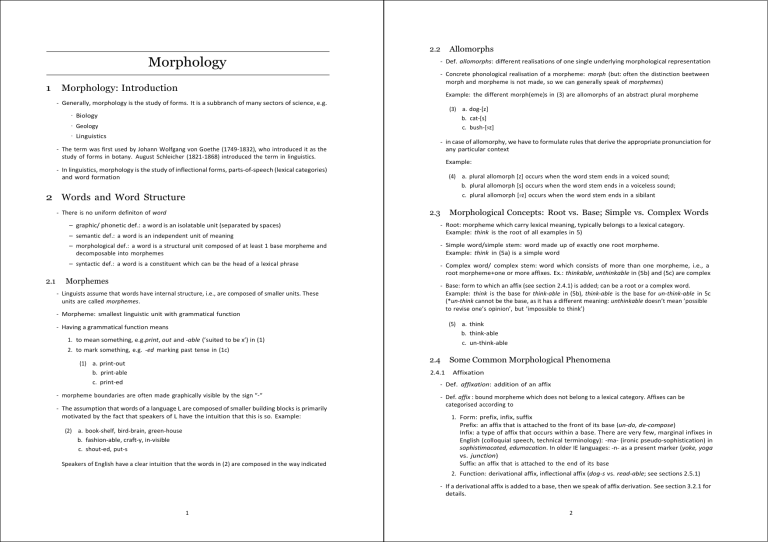
2.2 Morphology 1 Allomorphs - Def. allomorphs: different realisations of one single underlying morphological representation - Concrete phonological realisation of a morpheme: morph (but: often the distinction beetween morph and morpheme is not made, so we can generally speak of morphemes) Morphology: Introduction Example: the different morph(eme)s in (3) are allomorphs of an abstract plural morpheme - Generally, morphology is the study of forms. It is a subbranch of many sectors of science, e.g. (3) a. dog-[z] b. cat-[s] c. bush-[9z] · Biology · Geology · Linguistics - in case of allomorphy, we have to formulate rules that derive the appropriate pronunciation for any particular context - The term was first used by Johann Wolfgang von Goethe (1749-1832), who introduced it as the study of forms in botany. August Schleicher (1821-1868) introduced the term in linguistics. Example: - In linguistics, morphology is the study of inflectional forms, parts-of-speech (lexical categories) and word formation (4) a. plural allomorph [z] occurs when the word stem ends in a voiced sound; b. plural allomorph [s] occurs when the word stem ends in a voiceless sound; c. plural allomorph [9z] occurs when the word stem ends in a sibilant 2 Words and Word Structure 2.3 - There is no uniform definiton of word – graphic/ phonetic def.: a word is an isolatable unit (separated by spaces) – semantic def.: a word is an independent unit of meaning 2.1 Morphological Concepts: Root vs. Base; Simple vs. Complex Words - Root: morpheme which carry lexical meaning, typically belongs to a lexical category. Example: think is the root of all examples in 5) – morphological def.: a word is a structural unit composed of at least 1 base morpheme and decomposable into morphemes - Simple word/simple stem: word made up of exactly one root morpheme. Example: think in (5a) is a simple word – syntactic def.: a word is a constituent which can be the head of a lexical phrase - Complex word/ complex stem: word which consists of more than one morpheme, i.e., a root morpheme+one or more affixes. Ex.: thinkable, unthinkable in (5b) and (5c) are complex Morphemes - Linguists assume that words have internal structure, i.e., are composed of smaller units. These units are called morphemes. - Morpheme: smallest linguistic unit with grammatical function - Base: form to which an affix (see section 2.4.1) is added; can be a root or a complex word. Example: think is the base for think-able in (5b), think-able is the base for un-think-able in 5c (*un-think cannot be the base, as it has a different meaning: unthinkable doesn’t mean ’possible to revise one’s opinion’, but ’impossible to think’) (5) a. think b. think-able c. un-think-able - Having a grammatical function means 1. to mean something, e.g.print, out and -able (’suited to be x’) in (1) 2. to mark something, e.g. -ed marking past tense in (1c) 2.4 (1) a. print-out b. print-able c. print-ed 2.4.1 Some Common Morphological Phenomena Affixation - Def. affixation: addition of an affix - morpheme boundaries are often made graphically visible by the sign “-“ - The assumption that words of a language L are composed of smaller building blocks is primarily motivated by the fact that speakers of L have the intuition that this is so. Example: (2) a. book-shelf, bird-brain, green-house b. fashion-able, craft-y, in-visible c. shout-ed, put-s Speakers of English have a clear intuition that the words in (2) are composed in the way indicated - Def. affix : bound morpheme which does not belong to a lexical category. Affixes can be categorised according to 1. Form: prefix, infix, suffix Prefix: an affix that is attached to the front of its base (un-do, de-compose) Infix: a type of affix that occurs within a base. There are very few, marginal infixes in English (colloquial speech, technical terminology): -ma- (ironic pseudo-sophistication) in sophistimacated, edumacation. In older IE languages: -n- as a present marker (yoke, yoga vs. junction) Suffix: an affix that is attached to the end of its base 2. Function: derivational affix, inflectional affix (dog-s vs. read-able; see sections 2.5.1) - If a derivational affix is added to a base, then we speak of affix derivation. See section 3.2.1 for details. 1 2 2.4.2 Cliticisation 2.4.5 Suppletion - Def. clitic: word that syntactically functions as a free morpheme, but phonetically appears as a bound morpheme; must be attached to another word (= host) - Def. suppletion: replacement of a morpheme with an entirely different morpheme in order to indicate a grammatical contrast. - 2 types of clitics: - Example: forms of be (am, are, is, were) 1. Proclitics: attach to the following word (o’the ’of the’; colloquial speech: s’not ’it is not’; French: j’ai ’I have’, l’eau ’the water’) 2.4.6 2. Enclitics: attach to the preceding word (Examples: I’m; you’re; she’s; they’ll; they’ve; Germ. dial. Haschesem gesaat? ’hav you told him about it?’) - 2 types of reduplication: - Cliticisation vs. affixation: 2.4.3 Reduplication - Def. reduplication: marking of a grammatical or semantic contrast by repeating all or part of the base to which it applies · Cliticisation superficially resembles affixation: in both cases an element that cannot stand alone is attached to a base 1. Full reduplication: repetition of a part of the base. Example: Malay rumah ’house’, rumah-rumah ’houses’ · Key difference: unlike affixes, clitics are members of a lexical category (verb, noun, pronoun, preposition) 2. Partial reduplication: repetition of the entire base. Example: Lat. currō ’I run’ (tense: present), cucurrı̄ ’I ran ’ (tense: perfect) 2.5 Internal change - Def. internal change: process that substitutes one nonmorphemic segment for another to mark a grammatical contrast - Examples: ablaut (=vowel gradation), umlaut (=i-mutation) (6) a. b. c. d. sing, sang, sung, song (ablaut marks difference in tense or aspect/ part of speech) bind, band (ablaut marks difference in lexical category) rise, raise (internal change1 marks difference in transitivity) goose, geese (umlaut marks contrast in number; so-called irregular plurals) Note (for your information only): From a diachronic perspective, ablaut and umlaut refer to different phenomena. Ablaut is a regular vowel alternation (marks tense, aspect and part of speech) which, in the case of IE languages, can be traced back to Indo-European (strong verbs!). Umlaut, on the other hand, is an innovation of North and West Germanic languages. It is an assimilation of an original /a/, /i/, /o/ and /u/ in the root morpheme typically due to an /i/ in an affix (e.g. plural suffix, certain verbal suffixes, comparative affix). Classification of Morphemes The English morpheme inventory can be classified according to three criteria: I with regard to meaning/ function II with regard to degree of autonomy III with regard to reproducibility 2.5.1 Ad (I): Classification Feature ’Meaning/ Function’ We distinguish between 3 classes of morphemes with regard to their meaning or function: 1. Root morphemes: morphemes which carry lexical meaning, and typically belong to a lexical category. A word made up of exactly one root morpheme is called simple word or simple stem. Example: ’think’ in (5a) is a root. 2. Derivational morphemes: morphemes which serve to form new words. Can change the lexical category of a word. Example: if the derivational morpheme -able is added to the verbal root think in (5b), the resulting derivate is an adjective. Derivational morphemes carry grammatical and (to some extent) lexical information: Differences between internal change and infixing: - the base into which a real infix is inserted typically exists as a separate form in the language (7) (edumacation - education) - in the case of internal change, there is no separate infixless form in the language (foot / feet and sing/ sang, but no forms *ft ’lower extremity of the leg’ or *sng ’produce words in a musical tone’). The segments affected by internal change are not morphemes themselves. → existence of internal change and infixing illustrates an important point about word structure: morphology is not always concatenative, i.e., not all word structure is built by assembling morphemes in an additive, linear fashion 2.4.4 Stress Shift - Def. stress shift: change in the placement of stress or tone to reflect a contrast in lexical category - Examples: "export - ex"port; "subject -sub"ject 1 Derivational morpheme -ise/ -ize -isation/ -ization -ity, -ism -ly Grammatical information verb noun noun adverb 3. Inflectional morphemes: morphemes which carry grammatical information and represent the grammatical categories of the inflected lexical categories (case, number, person, gender, tense, aspect, voice, modality, comparison) (8) Inflection in English lexical category inflects for verb person/ number (3rd sing.), tense (past), aspect (progressive), past participle noun number (plural), “case“ (possessive) adjective comparison (comparative, superlative) deverbal adverb comparison (comparative, superlative) From a diachronic perspective, this internal change is an umlaut. Synchronically, however, it is perceived as ablaut. 3 Lexical information [action] [action] [abstract] 4 2.5.2 Ad (II): Classification Feature ’Degree of Autonomy’ We distinguish between 2 classes of morphemes with regard to degree of autonomy: - Free morpheme: morpheme that can stand alone in a given clause, i.e., without having to be bound to another morpheme - Bound morpheme: morpheme that has to be attached to another element Example: in (9) and (10), un- is a bound morpheme, happy and not are free morphemes (9) a. b. She is not happy What is she not? We live next to a green "house (green We live next to a very green house house: phrase) " Ad (III): Classification Feature ’Reproducibility’ 1. Reproducible morphemes: usually, morphemes are saved in our mental lexicon and can be recalled again for new combinations. 99% of the morpheme inventory belongs to this class 2. ’Cranberry’ morphemes (=unique morphemes): “paralysed“ base morphemes, mostly dialect, obsolete or misanalysed forms, which are generally bound and usually exist in only 1 combination (can only interpreted diachronically). Examples: lukewarm (Middle English luke “tepid“); cranberry (cran < crane); twilight (twi ’two’ [German zwie-]) Types of Word Formation - Word formation: study of the structure of complex words, concerned with the rules of combining smaller building blocks to form bigger units. Can be called “word syntax“. 3.1 (13) a. The player drop-kicks the ball through the goalposts b. * The player drops-kick the ball through the goalposts (14) a. b. - We distinguish between 2 classes of morphemes with regard to reproducibility: 3 (12) a. The [bird watcher]sg aims the binoculars at the rock b. * The [birds watcher]pl aim the binoculars at the rock c. The [bird watchers]pl aim the binoculars at the rock d. * The [birds watchers]pl aim the binoculars at the rock · To identify compounds with Adj as first element: the adjective in the compound cannot be modified by a word like very (10) a. She is unhappy b. * What is she un? 2.5.3 · Tense + plural markers cannot be attached to the first element, although they can be added to the compound as a whole (with very few exceptions) Compounding - Def. compounding : word formation process by which two or more root morphemes or bases are combined (15) a. We live next to a "greenhouse ( greenhouse: b. * We live next to a very greenhouse " compound) - Endocentricity vs. exocentricity: the grammatical and semantic features of the head determine the grammatical and semantic features of the whole coumpound. The grammatical and the semantic head of a word can be word-internal or word-external. · Endocentric compound: Coumpound in which the grammatical and the semantic head are inside the word. Example: (16) a. red fox : ’red’ is an adjective, ’fox’ is a noun. ’Fox’ is the head of the compound, determining its category (N, not Adj). ’Fox’ is also the semantic head: a red fox is a special kind of fox. b. cherry-red : ’cherry’ is a noun, ’red’ is an adjective. ’Red’ is the head of the compound, determining its category (Adj, not N). ’Red’ is also the semantic head: cherry-red is a special kind of red. · Exocentric compound: Coumpound in which the grammatical or the semantic head, or both, are not visible in the word, i.e., the meaning of the compound is not the sum of the meanings of its parts. Example: · Closed form: elements of the compound appear graphically as one word (lawsuit, wallpaper ) (17) a. Bluebeard : ’blue’ is an adjective, ’beard’ is a noun. ’Beard’ is the head of the compound, determining its category (N, not Adj). However, ’beard’ is not the semantic head of the compound: Bluebeard is not a beard which is blue, but a man with a blue beard. The grammtical head is word-internal, the semantic head is word-external b. forget-me-not : ’forget’ is a verb, ’me’ is a pronoun, ’not’ is an adverb. However, the compound is a noun. Furthermore, a ’forget-me-not’ is neither a kind of forgetting, nor a kind of ’me’, nor a kind of ’not’, but a special kind of flower. The grammtical and the semantic head are therefore both word-external. · Hyphenated form: elements of the compound are connected by a hyphen (blue-green, mother-of-pearl, house-builder ) Note: whereas endocentric compounds employ the usual irregular plural, the exocentric compounds permit the plural suffix -s for tooth, foot etc.: - Compound words are nouns, verbs or adjectives (with very few exceptions) - The morpheme which determines the word category and the meaning of the entire word is called the head of the word. In most compounds, the head is the rightmost morpheme. - Forms of compounds: · Spaced form: elements of the compound are separated (distance learning, winter holidays) - Properties of compounds (can be used to differentiate between compounds and identical looking non-compounds): · Stress: adjective-noun compounds have main stress on their first component; in noncompounds consisting of an adjective + noun, the second element is generally stressed (11) a. blackbird ["blækb3d] b. black bird [blæk "b3d] (18) bluetooth - bluetooths (*blueteeth); blackfoot - blackfoots (*blackfeet ); walkman - walkmans (*walkmen) - Types of compounds: 1. Coordinative/ copulative compound: compound with 2 heads which are both semantically equal and belong to the same word category (author-publisher, green-blue, bittersweet ) 2. Determinative compound: the meaning of the head is narrowed/ restricted by the meaning of the other constituent(s) 5 6 (a) Determinative compound in the narrower sense: determinative compound with word-internal grammatical and semantic head. The relation between head an determining constituent can be i. a part-of relation (crystal glass) ii. an argument relation (birdwatcher ) iii. a functional relation (wine glass) (b) Possessive compound: determinative compound with word-external semantic head (greenhorn, scaredy-cat ) 3.2 3.2.3 - Example 1: suffix -ant can only combine with Latinate bases (lexical constraint) (21) Derivation (22) - 2 types of derivation: (23) a. *stealer is blocked by thief b. *ungood is blocked by bad c. *seeable is blocked by visible d. *wellness is blocked by health/ wellbeing 2. Zero derivation/ conversion (implicit derivation) Affix Derivation (Explicit derivation) - Def. affix derivation (=explicit derivation): construction of new words by means of phonetically realised derivational affixes - In section 2.4.1, affixation was treated as the morphological process of adding an affix to a base. If a derivational affix is added to a base, then we speak of affix derivation. If an inflectional affix is added to a base, then we speak of inflection. a. whiten, soften, madden, quicken b. *greenen, *bluen, *abstracten, *angryen, *slowen - Example 3: words formed with otherwise productive affices are unacceptable to native speakers because they are “blocked“ by already existing words with the same meaning (blocking [lexical constraint]) - derivation can apply more than once (i.e., it is possible to create multiple levels of word structure) 1. Affix derivation (explicit derivation) a. defend-ant, assail-ant, contest-ant, serv-ant b. *fightant, *teachant - Example 2: suffix -en can only combine with monosyllabic bases ending in an obstruent (phonological costraint) - Def. derivation: word formation process by which a base is combined with an affix to forms a word with a meaning and/or lexical category distinct from that of its base 3.2.1 Constraints on Derivation - Derivation does not apply freely 3.3 Other Processes of Word Formation 3.3.1 Backformation - Def. backformation: creation of a neologism by removing a real or supposed affix from a word perceived as derived, and thereby reconstructing a base which did not exist before - Examples: baby-sitter - baby-sit; laser - lase; editor - edit - 2 types of derivational affixes in English: 1. Class 1 affixes: often trigger changes in the consonant or vowel segments of the base and may affect stress placement, often combine with bound roots, mostly of Latinate origin Examples: san-ity, democrac-y, product-ive, part-ial, public-ize, audacious, nat-ion 2. Class 2 affixes: tend to be phonologically neutral, having no effect on the segmental makeup of the base or on stress placement Examples: prompt-ness, hair-less, hope-ful, quiet-ly, defend-er, self-ish, commend-able - when both affix types appear in the same word, the Class 1 affix must normally occur closer to the root than the Class 2 affix (normally forms in which a Class 2 affix appears closer to the root are not possible words) Examples: (19) fear - less - ness root 1 2 3.3.2 Incorporation - Def. incorporation: phenomenon by which a word (usually a verb) forms a kind of compound with an object (usually the direct object) or modifier, while retaining its original syntactic function - English examples (very rare): babysit, breastfeed - Chukchi (Chukchi Peninsula/ Siberia): T9meyn9levtp9Yt9rk9n ’I have a fierce headache’ (24) t- 9- meyn- 9levt- p9Yt- 9rk9n 1- SG- SUBJ- great- head- hurt- PRES- 1 ‘I have a fierce headache’ 3.3.3 Word Reduction - Def. word reduction: reduction/ shortening/ abbreviation of an original word. The resulting word is equivalent to the base in meaning and lexical category (20) * fear - ness - less root 2 1 - Types of word reduction: - distinction between Class 1 affixes and Class 2 affixes is made to have a tool to describe these findings and predict/ generalise from them 3.2.2 Zero derivation/ Conversion (Implicit derivation) - Def. zero derivation (=conversion): construction of new words without phonetically realised derivational affixes; an already existing word is assigned a new syntactic category - Examples: red - the red; the mail - to mail; to guess - the guess 7 1. Clipping: shortening of a polysyllabic word by deleting one or more syllables Examples: demo(nstration), (E )lisa(beth), (tele)phone, (we)blog 2. Blending: “mixture“ of non-morphemic parts of two already existing items, usually the first part of one and the final part of the other Examples: smog (smoke+fog), motel (motor+hotel), brunch (breakfast+lunch) 3. Acronym formation: initial letters of (some or all) words in a phrase or title are contracted and pronounced as a word Example: PIN (Personal Identification Number ), MIT (Masachusetts Institute of Technology), Laser (Light Amplification by Stimulated Emission of Radiation) 8 3.3.4 Word manufacture (Coinage) - Person: morphological category that marks the participant role of a referent, such as the speaker, the addressee, and others. - Def. word manufacture (=coinage): creation of a word “from scratch“; especially common for product names - Person + number can be marked by 1 inflectional form - Examples: chirrup, blatant, muggle - Example: Spanish verb agreement 3.3.5 Person Onomatopoeia - Def. onomatopoeia: creation of a word to sound like the thing it names 1. 2. 3. - Examples: tick-tock, swoosh, zap, beep, buzz - Def. inflection: modification of a the form of a word (through affixation, internal change, reduplication or suppletion) to indicate the grammatical subclass to which it belongs. Dominant inflectional process: affixation - Agreement: a category A agrees with a category B if it is inflected for properties (such as person and number) of category B - Example: in French adjective phrases, the adjective agrees with the noun in number and gender General example: inflection marks/signals contrasts such as singular versus plural and past versus non-past Gender Masc Fem. - Base to which an inflectional affix is added: stem - Regular vs. irregular inflection in English: most inflection in English involves regular affixation (i.e., inflected forms are constructed as needed in accordance with a general morphological rule). However, some words mark inflectional contrasts irregularly (forms must be stored permanently in the language user’s memory) - 3 criteria to distinguish between inflectional and derivational affixes: 1. Category change – Inflection does not change either the grammatical category or the type of meaning found in the word to which it applies – Derivational suffixes characteristically change the category and/or the type of meaning of the form to which they apply and are therefore said to create a new word 2. Order Pl café chaud-s soupes chaud-es Tense - Tense: category that encodes the time of an event with reference to the moment of speaking 4.2.3 Noun Class - some languages divide nouns into classes based on shared phonological and/or semantic properties (for example: gender system) 4.2.4 Case - Def. case: category that encodes information about the grammatical role of an element - set of related nominal forms: nominal paradigm or declension – A derivational affix must combine with the base before an inflectional affix does (alignment: root - affder - affinfl ) – Thus, inflection takes place after derivation 3. Productivity – Def. productivity - degree to which native speakers use a particular grammatical process (in this case: inflection and derivation) with new bases of the appropriate category to produce novel forms – Inflectional affixes: tend to be highly productive (i.e., easily apply to new appropriate bases) – Derivational affixes: tend to be lowly productive (i.e., apply to restricted classes of bases) - Important for your general knowledge (and important research topic): languages of the world can be classified into 2 groups depending on the pattern of how verbal arguments (subject, direct object) are marked · Accusative case marking pattern: in some languages, the subject of intransitive and transitive verbs receive the same case marking (nominative). The direct object of a transitive verb receives a special case marker (accusative). Example: German is a language with accusative pattern ( Er NOM zeichnet. / Er NOM zeichnet [einen Entwurf ]ACC. ) · Ergative case marking pattern: in other languages, the subject of an intransitive verb and the direct object of a transitive verb receive the same case marking (absolutive). The subject of a transitive verb receives a special case marker (ergative). · Example: Basque is a language with ergative pattern (25) a. Jon-ek saltatu du Jon-ERG jump.PART-PERF have.3SG Examples of Inflection 4.2.1 4.2.2 Number Sg café chaud-ø soupe chaud-e - Example: English inflects for present (walk - walks) and past (walked ); French inflects for present (chanter - chante), imperfect (chantait), ’simple past’ (chanta) and future (chantera) Inflection versus Derivation 4.2 Pl cantamos cantáis cantan - set of inflectional forms associated with a verb: verbal paradigm or conjugation 4 Inflection 4.1 Number Sg canto cantas canta Person and Number ‘Jon jumped’ - Number: morphological category that marks contrast of countable quantities - Example: English -s marks plural b. Jon-ek ardo-a-Ø ekarri du Jon-ERG wine-DET-ABS bring.PART-PERF have.3SG ‘Jon brought the wine’ 9 10
